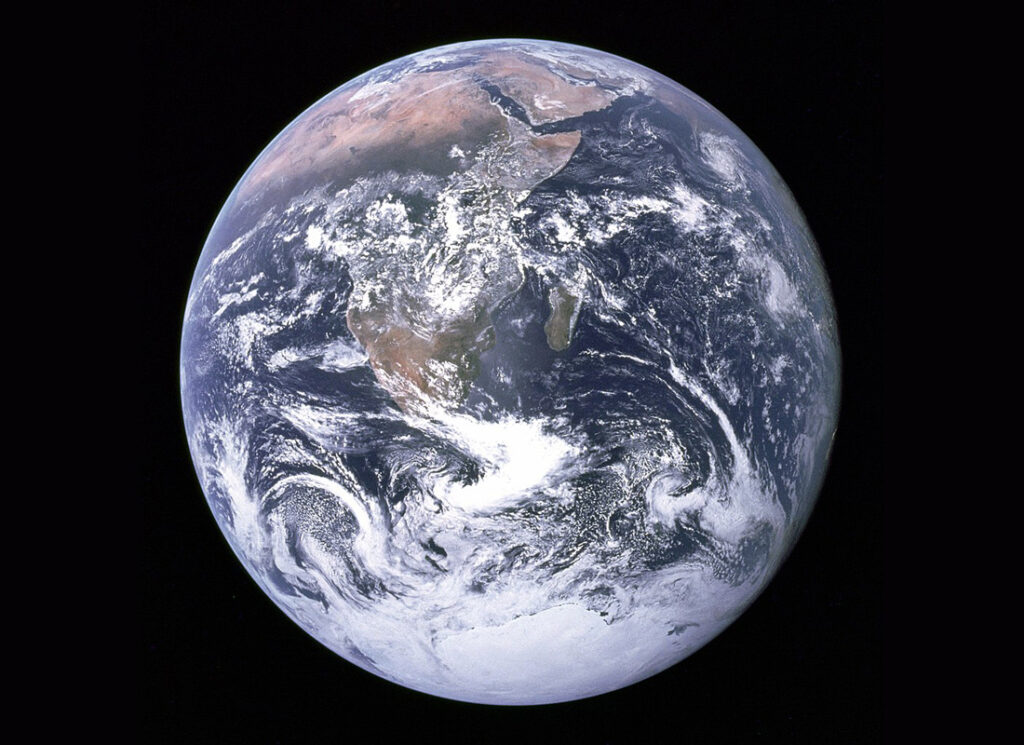Our home planet, Earth is the only planet in our solar system on which there is life – life forms in a great variety. All we need to live is protected under our atmosphere that protects us from the hostile environment of space. The earth is composed of complex, cross linked systems, which are difficult to predict. Air, water, earth and life – including human – represent forces that constantly influence and change our planet.
From the perspective of space, we have the unique opportunity to see the Earth as a whole. Scientists around the world have found out a lot about our planet by collaboration and cooperation.

Some facts are well known. For example, that Earth is the third planet from the Sun and the fifth largest in the solar system. The diameter of the Earth is a couple of one hundred kilometers larger than that of Venus. The 4 seasons are the result of the rotation of the earth that slopes more than 23 degrees to the ecliptic.
The deep oceans cover almost 70 % of the earth’s surface. Fresh water exists in liquid form only within a temperature range of 0° C to 100° C. This temperature range is relatively small, compared to the temperature ranges that are found in the Solar System. The availability and distribution of water vapor in the atmosphere is responsible for the weather on Earth.
Near the surface we are surrounded by an air envelope consisting of 78% nitrogen (N2), 21% oxygen (O2) and 1% other constituents. This atmosphere causes the long-term climatic and short-term weather changes on the planet and protects us from harmful radiation from the sun and meteorite impacts – most meteorites burn up in the atmosphere before they hit the ground. Satellites have revealed that the upper atmosphere of the earth swells during the day by the solar activity and contracts again at night.
The rapid rotation of our planet and its liquid nickel-iron core cause a magnetic field that distorts the solar winds. The solar wind is a constant stream of emitted particles, which are emitted by the sun. The magnetic field does not dissolve into space and has defined boundaries. When the solar wind particles are captured by the magnetic field, they collide with air molecules above the magnetic poles of the earth. These air molecules begin to shine and become Aurora or Northern or Southern Lights, also known as aurora.
The Earth´s surface is in constant motion. For example, the American continent is moving west across the bottom of the Pacific Ocean about as fast as our fingernails grow. Earthquakes occur when plates abut, when they quarreled arise Mountains, or they disintegrate. These movements are called plate tectonics. This theory was developed in the last 30 years, and it explains and combines the results of all studies on our planet. Before it was proposed, that the plates do not move.
From the viewpoint of the universe, we can see our planet as a whole like we do with other planets, and thus we should utilize the same exact instruments to understand the delicate balance of oceans, air, land and life.
| Discovery date | unknown |
| Semi-major axis | 149 597 870 km = 1.495 x 108 km (1.00 AU) |
| Perihelion | 147 054 706 km = 1.470 x 108 km (0.983 AU) |
| Aphelion | 152 141 033 km = 1.521 x 108 km (1.017 AU) |
| Diameter | 12 756.28 km = 1.275628 x 104 km Comparison: 1.00 x Earth |
| Volume | 1 083 200 000 000 km3 = 1.0832 x 1012 km3 Comparison: 1.00 x Earth |
| Mass | 5 973 700 000 000 000 000 000 000 kg = 5.9737 x 1024 kg Comparison: 1.00 x Earth |
| Density | 5.515 g/cm3 Comparison: 1.00 x Earth |
| Escape velocity | 40 248 km/h = 11 180 m/s Comparison: 1.00 x Earth |
| Sidereal rotation period | 1 Earth day 23.934 hours |
| Orbital period (Length of a year) |
1 Earth year 365.24 Earth days |
| Average orbital speed | 107 229 km/h = 29 786 m/s Comparison: 1.00 x Earth |
| Eccentricity | 0.01671022 |
| Inclination | 0.00005° |
| Axial tilt | 23.45° Comparison: 1.00 x Earth |
| Peripheral orbit | 924 375 700 km = 9.243757 x 108 km Comparison: 1.00 x Earth |
| Minimum/Maximum surface temperature |
-88/58 °C = 185/331 K |
| Composition of the atmosphere |
Nitrogen (N2), Oxygen (O2) |
Moons:
The Earth has one moon.